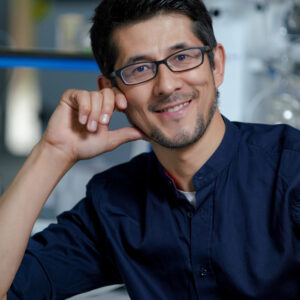Advancements in Green Chemistry
The 2023 IUPAC-Zhejiang NHU International Award for Advancements in Green Chemistry was announced and presented during the 49th IUPAC World Chemistry Congress in The Hague, The Netherlands. We congratulate Professor Xile Hu from the Swiss Federal Institute of Technology, Switzerland as the experienced chemist award winner, and Dr. Mirabbos Hojamberdiev from Technical University Berlin, Germany, Dr. Jiayu Peng from Department of Materials Science and Engineering, Massachusetts Institute of Technology, USA, and Dr. Zhe Zhuang, Department of Chemical and Systems Biology, Stanford University, USA as the young award winners.
The IUPAC-Zhejiang NHU International Award for Advancements in Green Chemistry is presented every two years. Each time, one award is presented to an experienced chemist (10000 $US), and three awards are given to three young chemists (2000 $US each) for their significant contributions to the field of green chemistry. The previous awards were presented in 2019 and 2021, respectively.
Professor Xile Hu has been invited to deliver a plenary lecture at the 10th IUPAC International Conference on Green Chemistry, 25-29 October 2024, Beijing, China, and the three young award winners have been invited to give invited lectures at this conference. In addition, each of the award winners is expected to write a short critical review for Pure and Applied Chemistry.
Main achievements of the winners
 The group of Professor Xile Hu has made many outstanding scientific discoveries in the field of Green Chemistry, particularly in Green Catalysis and Green Energy. In the area of green catalysis, they have developed new catalytic methods and catalysts that are based on earth-abundant elements for organic synthesis. In the area of green energy, Prof. Hu and his team have developed a number of novel earth-abundant electrocatalysts for the hydrogen and oxygen evolution reactions (HER and OER), which are the two half-reactions for water splitting, the main route to green hydrogen. They have made significant contributions to highly active earth-abundant catalysts for the hydrogen oxidation reaction, the key cathodic reaction in fuel cells. They have also invented superior anion exchange membranes (AEMs) for next-generation membrane water electrolyzers and fuel cells. They have demonstrated record-setting efficiencies in AEM electrolyzers and fuel cells. His group has made breakthrough catalysts and systems for CO2 and CO electroreduction. Their work is not only of fundamental value but has significant potential in industrial applications. For example, a startup company, NovaMea SA, has been founded based on their work in green energy.
The group of Professor Xile Hu has made many outstanding scientific discoveries in the field of Green Chemistry, particularly in Green Catalysis and Green Energy. In the area of green catalysis, they have developed new catalytic methods and catalysts that are based on earth-abundant elements for organic synthesis. In the area of green energy, Prof. Hu and his team have developed a number of novel earth-abundant electrocatalysts for the hydrogen and oxygen evolution reactions (HER and OER), which are the two half-reactions for water splitting, the main route to green hydrogen. They have made significant contributions to highly active earth-abundant catalysts for the hydrogen oxidation reaction, the key cathodic reaction in fuel cells. They have also invented superior anion exchange membranes (AEMs) for next-generation membrane water electrolyzers and fuel cells. They have demonstrated record-setting efficiencies in AEM electrolyzers and fuel cells. His group has made breakthrough catalysts and systems for CO2 and CO electroreduction. Their work is not only of fundamental value but has significant potential in industrial applications. For example, a startup company, NovaMea SA, has been founded based on their work in green energy.
Follow his work at https://orcid.org/0000-0001-8335-1196
 Dr. Mirabbos Hojamberdiev works on the development of strategies to synthesize mixed-anion compounds for artificial photosynthesis. He explores perovskite oxynitrides as one of the promising photocatalysts for water oxidation due to their absorption of visible light, small bandgap energy, good stability, and nontoxicity. He has significantly enhanced water oxidation performance of perovskite barium tantalum oxynitride by modulating the key parameters, such as photon absorption, charge generation, charge separation, charge transport, and surface properties, by engineering the morphology and textural parameters, stability, and electronic, crystal, and defect structures. His innovative strategies have allowed the synthesis of perovskite oxynitrides with less defect density at lower temperature and shorter time. The systems that he developed have exhibited high efficiency and stability, which are important for the application of solar water-splitting reactions to generate green hydrogen in the future. Green hydrogen generated from solar water splitting may play an important role in achieving sustainable development goals.
Dr. Mirabbos Hojamberdiev works on the development of strategies to synthesize mixed-anion compounds for artificial photosynthesis. He explores perovskite oxynitrides as one of the promising photocatalysts for water oxidation due to their absorption of visible light, small bandgap energy, good stability, and nontoxicity. He has significantly enhanced water oxidation performance of perovskite barium tantalum oxynitride by modulating the key parameters, such as photon absorption, charge generation, charge separation, charge transport, and surface properties, by engineering the morphology and textural parameters, stability, and electronic, crystal, and defect structures. His innovative strategies have allowed the synthesis of perovskite oxynitrides with less defect density at lower temperature and shorter time. The systems that he developed have exhibited high efficiency and stability, which are important for the application of solar water-splitting reactions to generate green hydrogen in the future. Green hydrogen generated from solar water splitting may play an important role in achieving sustainable development goals.
Follow his work at https://orcid.org/0000-0002-5233-2563
 Dr. Jiayu Peng works on the development of activity and stability design principles for catalyst optimization. His research tackles the scientific question—how to understand, control, and engineer catalysts on the atomic scale to have optimal activity and stability for diverse renewable technologies. Combining electrochemistry, physical chemistry, and materials science, he has developed physics-driven catalyst design principles for activity and stability optimization. He has identified one of the first-ever sets of stability design principles for preventing catalyst degradation in acid, where modulating the electronic structure of transition metal oxides and nitrides stabilizes them against dissolution in acidic electrolytes. Furthermore, he has shown that tuning the electron-withdrawing capability of heterometal substituents in transition metal oxide catalysts can optimize their bonding properties, reaction barriers, and catalytic activity for boosting electrochemical water splitting to produce hydrogen fuels. Such principles highlight a physically meaningful framework with quantitative predictive power for accelerating catalyst design to combat the most recalcitrant, urgent societal challenges in sustainability and decarbonization, including climate change, environmental pollution, energy poverty, and food insecurity.
Dr. Jiayu Peng works on the development of activity and stability design principles for catalyst optimization. His research tackles the scientific question—how to understand, control, and engineer catalysts on the atomic scale to have optimal activity and stability for diverse renewable technologies. Combining electrochemistry, physical chemistry, and materials science, he has developed physics-driven catalyst design principles for activity and stability optimization. He has identified one of the first-ever sets of stability design principles for preventing catalyst degradation in acid, where modulating the electronic structure of transition metal oxides and nitrides stabilizes them against dissolution in acidic electrolytes. Furthermore, he has shown that tuning the electron-withdrawing capability of heterometal substituents in transition metal oxide catalysts can optimize their bonding properties, reaction barriers, and catalytic activity for boosting electrochemical water splitting to produce hydrogen fuels. Such principles highlight a physically meaningful framework with quantitative predictive power for accelerating catalyst design to combat the most recalcitrant, urgent societal challenges in sustainability and decarbonization, including climate change, environmental pollution, energy poverty, and food insecurity.
Follow his work at https://orcid.org/0000-0003-3696-770X
 Dr. Zhe Zhuang works on advancing the field of C−H functionalization reactions of native substrates using practical oxidants and catalysts. He has developed a range of C(sp3)−H functionalization reactions that utilize inexpensive and industry-compatible oxidants, namely tert-butyl hydrogen peroxide and sodium percarbonate, with the potential for large-scale manufacturing. In contrast to traditional multi-step synthesis approaches, His methodologies enable the streamlined, one-step synthesis of biologically significant scaffolds from readily available starting materials, such as aliphatic carboxylic acids and amines. The utility of these protocols has been demonstrated through their applications in late-stage functionalization of natural products and pharmaceutical compounds, as well as in total synthesis endeavors. For example, he has developed a method for the direct synthesis of β-lactones from readily available aliphatic acids. This approach yields a versatile intermediate for constructing diverse compound library in medicinal chemistry and serving as a covalent warhead in drug discovery. The use of inexpensive and practical tert-butyl hydrogen peroxide in water, combined with the ease of product purification without the need for column chromatography, render this reaction scalable and potentially amenable to tonne-scale manufacturing.
Dr. Zhe Zhuang works on advancing the field of C−H functionalization reactions of native substrates using practical oxidants and catalysts. He has developed a range of C(sp3)−H functionalization reactions that utilize inexpensive and industry-compatible oxidants, namely tert-butyl hydrogen peroxide and sodium percarbonate, with the potential for large-scale manufacturing. In contrast to traditional multi-step synthesis approaches, His methodologies enable the streamlined, one-step synthesis of biologically significant scaffolds from readily available starting materials, such as aliphatic carboxylic acids and amines. The utility of these protocols has been demonstrated through their applications in late-stage functionalization of natural products and pharmaceutical compounds, as well as in total synthesis endeavors. For example, he has developed a method for the direct synthesis of β-lactones from readily available aliphatic acids. This approach yields a versatile intermediate for constructing diverse compound library in medicinal chemistry and serving as a covalent warhead in drug discovery. The use of inexpensive and practical tert-butyl hydrogen peroxide in water, combined with the ease of product purification without the need for column chromatography, render this reaction scalable and potentially amenable to tonne-scale manufacturing.
The IUPAC-Zhejiang NHU International Award, managed by the ICGCSD, is presented every two years. Look for the announcement of the next call in 2024 ahead of the 2025 IUPAC World Chemistry Congress that will take place in Malaysia. For further information about the IUPAC-Zhejiang NHU International Award, see https://iupac.org/what-we-do/awards/.
Originating Call for Nominations (posted 20 Dec 2020)
Announcement published in Chem Int Oct 2023, pp. 23-25. https://doi.org/10.1515/ci-2023-0405
